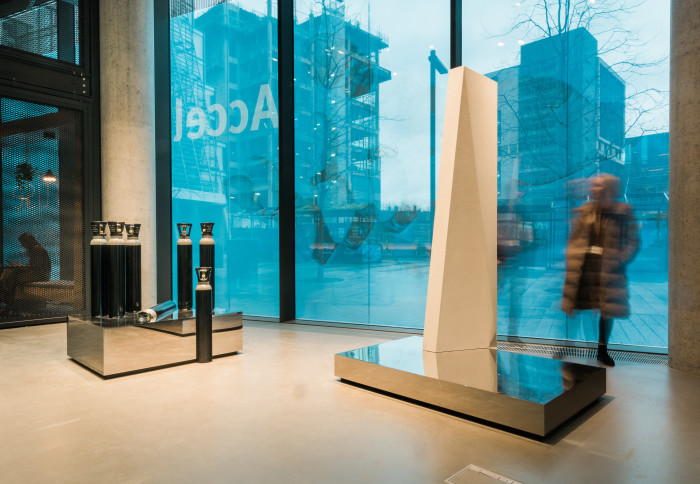Joining the dialogue about CO2
by Jan Carberry

The new two piece artwork in the lobby of Sir Michael Uren Hub. which stands in dialogue
'Absence Echoed' exploring the concept of the reduction of C02, now stands in the lobby of the Sir Michael Uren Hub, White City Campus.
'Absence Echoed’, a new artwork by David Rickard, now stands in the lobby of the Sir Michael Uren building at White City Campus.
The artist was commissioned by College to realise an artwork that bears testament to the life and work of benefactor Sir Michael Uren and the building in which it stands.
The former alumni, who died in 2019 at the age of 95, pioneered the use of ground granulated blast furnace slag (GGBS), an industrial waste product, to manufacture a new kind of cement with 90% less carbon emissions than traditional methods. This cement has been used within the cladding fins of the Sir Michael Uren Hub.
Creating dialogue
The artist has created two pieces, which stand in dialogue with each other, exploring the concept of the reduction of CO2 emissions.
One is a single cladding ‘fin’ as on the front of the building, cut in half and reflected within a mirror polished stainless steel base to find its full height. The other is a cluster of industrial gas cylinders that embody the relative CO2 savings due to the hidden ingredient of GGBS. This includes cylinders embedded and halved within the stainless steel base. Combining concrete, gas cylinders and polished stainless steel, the sculptures reflect the physical elements, while making visible their typically hidden qualities.
David Rickard said: “Absence in this case is a positive term, as it is the absence of CO2, and echoed refers to the reflections in the stainless steel and dialogue between the sculptures.”
“The half height fins reach their full height in the stainless steel, and the reflection is a physical representation for the amount of CO2 saved by the GGBS process.”
“The cylinders bring the ‘back of house’ into the front of house and into the conversation and echo the fin’s CO2 savings.”
The volume of CO2 saved by using GGBS within the single precast concrete cladding fin has been calculated as 78.2kg CO2e, based on the volume of GGBS and its CO2 footprint compared to using standard cement.
Calculated for the 1,300 concrete fins covering the Uren Hub facade this equates to a saving of approximately 100 tonnes of CO2.
Concrete for the sculpture was produced by Loveld, Belgium and fabrication of the sculptures was by Benson Sedgwick in the UK. The artwork was funded by The Michael Uren Foundation. Estates Capital Projects Programme Manager Bruna Santandrea has overseen the installation works.
Sir Michael Uren
Sir Michael was one of the UK’s most generous philanthropists, and stands as the biggest benefactor in Imperial’s history, donating £40m to the cost of the building that bears his name.
Article text (excluding photos or graphics) © Imperial College London.
Photos and graphics subject to third party copyright used with permission or © Imperial College London.
Reporter
Jan Carberry
Estates Division